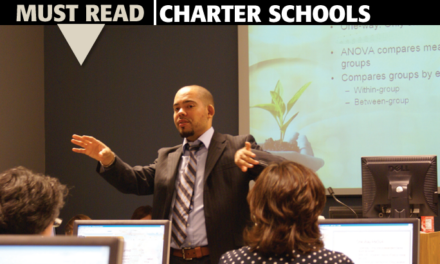The authors recommend four practical strategies to help build a successful teacher-mentoring program.
In recent years, there has been a proliferation of mentoring programs for new teachers. And no wonder. Effective mentors can pave the way for novices to make a successful transition into teaching, weather the emotional turbulence of their first years, and make sense of the culture, context, policies, and instructional priorities of their new workplace. Research suggests that mentoring has positive effects on beginning teachers’ job satisfaction, professional development, and retention (Bullough, 2012; Ingersoll & Strong, 2011; Kardos & Moore Johnson, 2010). In addition, when skilled veterans step into the role of mentor, they expand their sphere of influence, strengthening their identity as teacher leaders.
But while the overall benefits of mentoring are clear, not all mentoring programs serve teachers as well as they could (Bullough, 2012; Kardos & Moore Johnson, 2010). So what makes mentoring work? Here are four practical, research-based strategies to ensure that mentoring programs provide the supports, structures, and resources your mentors and mentees need:
1) Set clear expectations.
When selecting mentors, keep in mind that good teachers do not necessarily make good mentors (Bullough, 2012). Yes, mentors must be effective teachers in their own right, but they must also be capable of providing certain kinds of professional support, such as helping novices identify and analyze critical problems of practice.
Just as important, administrators must define the mentor’s role clearly from the start, making sure they understand precisely what they will and will not be expected to do: Will they serve strictly as mentors, or will they also be asked to assess new teachers’ skills and progress? Will mentors or mentees have any say about who they are partnered with? Is it possible to match mentors and mentees by content area and/or grade level, which can have positive effects on teacher learning and retention (Bay & Parker-Katz, 2009; Kardos & Moore Johnson, 2010)? Where and when will mentors and mentees meet with each other, and what steps will be taken to free up regular, predictable times in their schedules (Gardiner, 2011)? While there is no consensus on the duration or intensity of mentoring needed, researchers have noted that mentored induction is most effective when it is intensive, sustained, and continuous (Ingersoll & Strong, 2011; Wei, Darling-Hammond, & Adamson, 2010).
The clearer the guidelines are, the easier it will be for mentors and mentees to build a trusting relationship, not just with each other but also with the administrators who supervise them (Carver & Feiman-Nemser, 2009; Covey & Merrill, 2008). In short, school leaders need to communicate early, often, and effectively about the purposes of and expectations for individual mentoring sessions and for the mentoring program as whole.
School leaders need to communicate early, often, and effectively about the purposes of and expectations for individual mentoring sessions and for the mentoring program as a whole.
2) Encourage mentoring from the inside.
Common mentoring practices can be grouped loosely into two complementary categories: outside and inside practices (Schwille, 2008). Outside practices occur before or after classroom instruction, when students are not present and teachers have time for collaborative problem solving, guided analysis of classroom data, and reflection on teaching and learning.
Outside practices tend to be the go-to strategies for most mentors (Schwille, 2008; Gardiner & Weisling, 2016). They include quick on-the-fly conversations about challenges, successes, or observed practices, as well as longer, regularly scheduled blocks of time for guided, in-depth reflection and analysis of practice and data. Pairs might work together to create lesson plans; analyze student work; view and discuss video of the mentee, the mentor, or another educator in the classroom; or engage in practice teaching, in which the mentor models or a mentee rehearses an instructional practice outside the classroom. (Detailed descriptions of many of these outside practices can be found at Elena Aguilar’s website, http://brightmorningteam.com, or in her book, The Art of Coaching (2013); resources are available also from the New Teacher Center at https://newteachercenter.org/resources.)
Some practices can be considered outside mentoring even though they involve spending time in the novice teacher’s classroom. For example, a mentor might sit in on the mentee’s class, collecting data on a specific aspect of their teaching practice, which they will share and discuss at a later meeting, without the students present. That is, while the mentor observes the mentee at work, the active part of the mentoring relationship goes on outside of the classroom.
Inside mentoring, by contrast, occurs in real time, during a lesson, while students are present. These practices tend to be rare, though (Schwille, 2008), and many mentors are reluctant to engage in them for a number of reasons: They worry that the work will demand too much of their time; they fear that their mentees will call on them to take over the classroom; they worry that if the lesson goes poorly, their own credibility will suffer; and they worry about usurping the new teacher’s authority (Gardiner & Weisling, 2016). Nonetheless, these inside practices can be particularly effective forms of mentoring, helping new teachers to improve their practice quickly. For example, consider a few key strategies:
Co-teaching
Collaborative teaching, in which the mentor and mentee plan and teach a lesson together, allows the mentor to model effective teaching while sharing some of the responsibilities. This arrangement, in which the veteran teacher is present and always available to help, often makes it easier for the mentee to take instructional risks. And should a lesson go badly, mentors can use it as a teachable moment, modeling how they can learn from the experience, regroup, and figure out next steps.
To get the most benefit from co-teaching, the mentor and mentee should plan their lesson together and assess its effectiveness afterward by analyzing student work or assessment data. In particular, it can be useful to record such lessons and watch the video together, highlighting effective and ineffective practices and discussing what to try next time. (Examples of such co-teaching videos are available at www.faculty.virginia.edu/coteachUVA/5formats.html.)
Demonstration teaching
Demonstration teaching (or modeling) is when the mentor demonstrates a particular lesson, practice, or strategy in front of the mentee’s students. Mentees see how an instructional practice works with their own students and how an expert teacher responds to the students on the fly.
When preparing for a demonstration lesson, the mentor should involve the mentee in the planning. It’s also important to set an observational focus for the mentee ahead of time and create a data-collection protocol for them to use. And as with co-teaching, both successful and unsuccessful lessons provide important opportunities for reflection and debriefing.
Stepping in
Sometimes a mentor steps in during instruction to provide nonverbal or whispered cues, take over a portion of instruction, or pose clarifying questions or feedback. These interventions, which may be totally impromptu or somewhat planned, can offer a struggling teacher temporary relief during a stressful lesson and prompt an immediate change in the classroom to improve management or instruction. They also give the new teacher a chance to observe an expert respond in the moment.
Mentees should be aware in advance that a mentor may occasionally step in during an observation and that they shouldn’t interpret this as a failing on their own part. Ideally, the mentor will assess the mentee’s comfort level before and after the lesson. Discussions before the lesson should focus on cues and methods of stepping in or asking for help. These might include hand signals, sticky notes, whiteboards, posters in the back of the room, or key words. Afterward, the mentor should explain to the new teacher the moves they made when stepping in so that the new teacher can incorporate them into their own practice. (For examples of how mentors can step in effectively, see Bambrick- Santoyo, 2016.)
Because mentors are sometimes reluctant to use these inside strategies, school administrators should be explicit in calling attention to them and defining them as standard practices, which mentors are expected to use. Further, they should provide mentors with initial and ongoing professional development focusing on the benefits of these practices, how and when to use them, common challenges, and how to respond to them. At the same time, mentees should be made aware that these practices do not entail criticism of their work but, rather, that they offer important tools that can be used to lighten the teaching load, facilitate risk taking, build a stronger working relationship with their mentor, and help them improve their teaching practice.
Finally, while it is important to encourage and support mentors’ use of inside practices, administrators should keep in mind that there is no one best way to support new teachers. The most effective mentors are flexible and strategic, using inside and outside practices as needed, depending on the given situation. Because new teachers grow faster with a mixture of both types of support (Bambrick-Santoyo, 2016), mentors should receive explicit training, practice, and ongoing support in how to use both practices.
Mentoring is a distinct profession with its own skills, knowledge, and practices, all of which must be developed and practiced.
3) Mentor the mentor.
Most mentors are experienced teachers who have a demonstrated track record of classroom success as evidenced by professional evaluations and student achievement data. Being effective in the classroom, however, does not automatically translate to success as a mentor. Rather, mentoring is a distinct profession with its own skills, knowledge, and practices, all of which must be developed and practiced with feedback, like any new skill (Aspfors & Fransson, 2015; Bullough, 2012; Carver & Feiman-Nemser, 2009).
Mentors need to be selected intentionally, given initial professional development, and provided ongoing support to learn how to use the tools available to them skillfully, flexibly, and effectively. This development can include:
- Professional development sessions, in which an expert practitioner presents content and provides a series of activities for the participants to engage in outside the classroom;
- Co-mentoring, which entails a partnership between two mentors, often one new and one veteran, and having them engage in any of the mentoring practices listed above; and
- Metacognitive mentoring, in which a manager or experienced mentor takes on the role of the mentor and the new mentor acts as the mentee as they practice various mentoring strategies.
Those responsible for supporting mentors are encouraged to use the same inside and outside practices they expect mentors to use. In this way, mentors benefit from the different outcomes supported by each tool and have the opportunity to experience each in action.
4) Tend to relationships.
It goes without saying that mentors and the new teachers they work with need to have strong professional relationships (Gardiner, 2011; Schwille, 2008). Less often noted, though, is that mentors should also build strong relationships with their mentees’ students (Gardiner & Weisling, 2016). When they do so, they tend to become more comfortable using inside mentoring practices: stepping in, demonstration teaching, and co-teaching with their mentees. They also tend to have greater insight into the novice teacher’s classroom, which gives them a better sense of how to prioritize their mentoring goals, select appropriate practices, and facilitate data discussions. It is important, then, for administrators to give mentors the time they need to get to know the students enrolled in their mentees’ classes.
For other reasons, too, administrators should make it a priority to maintain good working relationships with the pairs of mentors and mentees that they supervise (Gardiner, 2011). When mentor teachers are seen as trusted members of a support team — and not as tattletales, playing “gotcha” with their mentees — then they can serve effectively as liaisons. On one hand, they can help new teachers understand and implement school policies; on the other hand, they can help administrators understand and respond to new teachers’ needs.
A sound investment
These four strategies have been shown to have positive effects on new teachers’ retention, instruction, and student learning outcomes. By setting clear expectations, encouraging the use of inside mentoring practices, mentoring the mentors, and tending to relationships, school administrators can increase the likelihood that novice educators will become effective and seasoned professionals.
References
Aguilar, E. (2013). The art of coaching: Effective strategies for school transformation. San Francisco, CA: Jossey-Bass.
Aspfors, J. & Fransson, G. (2015). Research on mentor education for mentors of newly qualified teachers: A qualitative meta-synthesis. Teaching and Teacher Education, 48, 75-86.
Bay, M. & Parker-Katz, M. (2009). Perspectives on induction of beginning special educators: Research summary, key program features, and the state of state-level policies. Teacher Education and Special Education, 32 (1), 17-32.
Bambrick-Santoyo, P. (2016). Get better faster: A 90-day plan for coaching new teachers. San Francisco, CA: Jossey-Bass.
Bullough, R. (2012). Mentoring and new teacher induction in the United States: A review and analysis of current practices. Mentoring and Tutoring: Partnership in Learning, 20 (1), 57-74.
Carver, C.L. & Feiman-Nemser, S. (2009). Using policy to improve teacher education: Critical elements and missing pieces. Educational Policy, 23 (2), 295-328.
Covey, S.M. & Merrill, R.R. (2008). The speed of trust: The one thing that changes everything. New York, NY: Free Press.
Gardiner, W.L. (2011). New urban teachers experience induction coaching: “Moving vision toward reality.” Action in Teacher Education, 33, 359-373.
Gardiner, W. & Weisling, N. (2016). Mentoring “inside” the action of teaching: Induction coaches’ perspectives and practices. Professional Development in Education, 42 (5), 671-686.
Ingersoll, R.M. & Strong, M. (2011). The impact of induction and mentoring programs for beginning teachers: A critical review of the research. Review of Educational Research, 81 (2), 201-233.
Kardos, S.M. & Moore Johnson, S. (2010). New teachers’ experience of mentoring: The good, the bad, and the inequity. Journal of Educational Change, 11 (1), 23-44.
Schwille, S.A. (2008). The professional practice of mentoring. American Journal of Education, 115, 139-167.
Wei, R.C., Darling-Hammond, L., & Adamson, F. (2010). Professional development in the United States: Trends and challenges. Dallas, TX: National Staff Development Council.
Citation: Weisling, N.F. & Gardiner, W. (2018). Making mentoring work. Phi Delta Kappan 99 (6), 64-69.
ABOUT THE AUTHORS

Nina F. Weisling
Nina F. Weisling is a chair and assistant professor of education at Carthage College, Kenosha, WI. She is a co-author of Responsive Mentoring: Supporting the Teachers All Students Deserve (Rowman & Littlefield, 2020).

Wendy Gardiner
Wendy Gardiner is the Jolita Benson Endowed Chair of Elementary Education at Pacific Lutheran University in Tacoma, WA.










